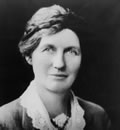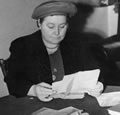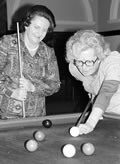MPs: Women in the House
For much of its first century Parliament was a bastion of male culture. Women could observe it from a discreet distance from the ladies' gallery, and by the 1880s the odd female reporter had ventured in, but she had only men's activities to report. Women got the vote in 1893, making New Zealand the first country to have full adult suffrage (or voting rights), but they could not stand for Parliament until 1919. It was not until 1933 that the first woman MP took her seat in the House. In the 1950s and 1960s there were still few women MPs; this was not to change until the 1980s. From then, women were appointed to cabinet in increasing numbers and to senior positions in Parliament such as whip and Deputy Speaker. From the 1990s women made up about 30 per cent of members. In 1997 Jenny Shipley became New Zealand's first female Prime Minister, then in 1999 Helen Clark led her Labour Party to victory.
The first woman MP
From 1919 a few women tried to get into Parliament, including Ellen Melville, who made several attempts to get elected in an Auckland seat. None succeeded until Labour's Elizabeth McCombs won the Lyttelton by-election in 1933. A fearless and fluent speaker, McCombs was deluged with correspondence from women and fought hard for women's issues. Parliament had to make some adjustments for her. The 'No Women Permitted' sign over Bellamy's dining room came down, the wording of the swearing-in ceremony was altered, and the Governor-General had to refer to 'members' rather than 'gentlemen' in the Speech from the Throne. But McCombs was not allowed into the inner sanctum of Bellamy's bar.
Members applauded loudly and the crowded galleries cheered as McCombs entered the House for the first time. After she bowed and took her seat, government members crossed the floor to congratulate her. On her desk were two bouquets, one from the ladies' gallery and another from 'an admirer'. The Speaker called it 'a scene unique in the parliament history of New Zealand'.
Gentlemen only
The election of Mabel Howard in 1943 caused a stir, for she had little truck with old-fashioned male-only customs. When she attempted to use a bathroom in the basement, a messenger pointed to the 'Gentlemen' sign. She pointed to the 'Members Only' sign in return, and was allowed in only after threatening to climb in through the window.
Women in a Men's World
It was not until the 1970s that women made inroads into the male culture of Parliament, but even then, progress was slow. A few outright prohibitions continued into the 1980s, in custom if not officially. The billiards lounge, now the Grand Hall in Parliament House, was for members only and women were not made welcome, although one or two braved the hostility to enter and play a game.
Women with children found parliamentary life particularly difficult, especially the mid-year start. Some women MPs timed the birth of their children around the parliamentary timetable. Whetu Tirikatene-Sullivan had done this in 1970, returning to the House two weeks after the baby's birth and looking after her child in her office. Over a decade later, new mothers still struggled to combine baby and work. Ruth Richardson gave birth during the 1983 recess, but when the House was called back early, she had to bring her young baby with her as she was still breast-feeding and a special room had to be arranged for her. It was not until the 1990s that Parliament established a childcare centre.
External link
More about Women in the House on the Parliamentary Service website.
Next: Maori MPs >


